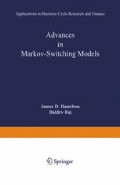Abstract
This chapter serves as a partial introduction to and survey of the literature on Markov-switching models. We review the history of this class of models, describe their mathematical structure, and exposit the basic ideas behind estimation and inference. The chapter also describes how the approach can be extended in a variety of directions, such as non-Gaussian distributions, time-varying transition probabilities, vector processes, state-space and GARCH models, and surveys recent methodological advances. The contributions of the other chapters in this book are reviewed. A final section offers conclusions and implications for policy.
Access this chapter
Tax calculation will be finalised at checkout
Purchases are for personal use only
Preview
Unable to display preview. Download preview PDF.
References
Acemoglu D, Scott A (1997) Asymmetric business cycles: Theory and time-series evidence. Journal of Monetary Economics 40:501–33
Albert J, Chib S (1993) Bayes inference via Gibbs sampling of autoregressive time series subject to Markov mean and variance shifts. Journal of Business and Economic Statistics 11:1–15
Ang A, Bekaert G (2001) Regime switches in interest rates. Journal of Business and Economic Statistics, forthcoming
Baum LE, Ted P, George S, Weiss N (1980) A maximization technique occurring in the statistical analysis of probabilistic functions of Markov chains. Annals of Mathematical Statistics 41:164–171
Chamley C (1999) Coordinating regime switches. Quarterly Journal of Economics 114:869–905
Chevalier JA, Scharfstein DS (1996) Capital market imperfections and countercyclical markups: Theory and evidence. American Economic Review 86:703–725
Cooper R (1994) Equilibrium selection in imperfectly competitive economics with multiple equilibria. Economic Journal 104:1106–1122
Cooper R, John A (1988) Coordinating coordination failures in keynesian models. Quarterly Journal of Economics 103:441–463
Cosslett SR, Lee L-F (1985) Serial correlation in discrete variable models. Journal of Econometrics 27:79–97
Diamond PA (1982) Aggregate demand management in search equilibrium. Journal of Political Economy, 90 (October): 881–894. Reprinted in Mankiw and Romer (1991) Eds. New Keynesian Economics 2 Volumes. Cambridge: MIT Press
Diamond PA, Fudenberg D (1989) Rational expectations business cycles in search equilibrium. Journal of Political Economy 97:606–19
Diebold FX, Lee J-H, Weinbach GC (1994) Regime switching with time-varying transition probabilities. In: Hargreaves C (ed) Nonstationary Time Series Analysis and Cointegration, Oxford: Oxford University Press
Dueker M (1997) Markov switching in GARCH processes and mean-reverting stock-market volatility. Journal of Business and Economic Statistics 15:26–34
Filardo AJ (1994) Business cycle phases and their transitional dynamics. Journal of Business and Economic Statistics 12:299–308
Filardo AJ, Gordon SF (1998) Business cycle durations. Journal of Econometrics 85:99–123
Frühwirth-Schnatter S (2001) Markov chain Monte Carlo estimation of classical and dynamic switching and mixture models. Journal of the American Statistical Association 96:194–209
Garcia R (1998) Asymptotic null distribution of the likelihood ratio test in Markov switching models. International Economic Review 39:763–788
Gray SF (1996) Modeling the conditional distribution of interest rates as a regime-switching process. Journal of Financial Economics 42:27–62
Greenwald BC, Stiglitz JE, Andrew W (1994) Informational imperfections in capital markets and macroeconomic fluctuations. American Economics Review 74 (May): 194–199
Hamilton JD (1989) A new approach to the economic analysis of nonstationary time series and the business cycle. Econometrica 57:357–384
Hamilton JD (1994a) Time series analysis. Princeton, NJ: Princeton University Press
Hamilton JD (1994b) State-space models. In: Engle R, McFadden D (eds) Handbook of Econometrics, Volume 4, pp. 3039–3080, Amsterdam: North Holland
Hamilton JD, Lin G (1996) Stock market volatility and the business cycle. Journal of Applied Econometrics 11:573–593
Hamilton JD, Perez-Quiros G (1996) What do the leading indicators lead? Journal of Business 69:27–49
Hamilton JD, Susmel R (1994) Autoregressive conditional heteroskedasticity and changes in regime. Journal of Econometrics 64:307–333
Howitt P (1988) Business cycles with costly search and recruiting. Quarterly Journal of Economics 103 (February): 147–165
Howitt P, McAfee P (1992) Animal spirits. American Economic Review 82:493–507
Jeanne O, Masson P (2000) Currency crises, sunspots, and Markov-switching regimes. Journal of International Economics 50:327–350
Keynes JM (1936) The general theory of employment, interest and money. London: Macmillan
Kim CJ (1994) Dynamic linear models with Markov-switching. Journal of Econometrics 60:1–22
Kim CJ, Nelson CR (1999a) Friedman’s plucking model of business fluctuations: Tests and estimation of permanent and transitory components. Journal of Money, Credit, and Banking 31:317–334
Kim CJ, Nelson CR (1999b) State-space models with regime switching. Cambridge, Massachusetts: MIT Press
Lindgren G (1978) Markov regime models for mixed distributions and switching regressions. Scandinavian Journal of Statistics 5:81–91
Neftci SN (1982) Optimal prediction of cyclical downturns. Journal of Economic Dynamics and Control 4:225–241
Rabiner LR (1989) A tutorial on hidden Markov models and selected applications in speech recognition. Proceedings of the IEEE 77:257–286
Raj B (2002) Asymmetries of business cycle: The Markov-switching approach. In: Ullah A, Wan A, Chaturvedi A (eds) Handbook of Applied Econometrics and Statistical Inference, Marcel Dekker, Chapter 31, pp 687–710
Romer D (1996) Advanced macroeconomics. NY: McGraw-Hill Companies, Inc
Sclove SL (1983) Time-series segmentation: A model and a method. Information Sciences 29:7–25
Shaprio C, Stiglitz JE (1984) Equilibrium unemployment as a worker discipline device. American Economic Review 74 (June): 433–444. Reprinted in Mankiw and Romer (1991) Eds. New Keynesian Economics 2 Volumes. Cambridge: MIT Press
Shephard N (1994) Partial non-gaussian state space. Biometrika 81:115–131
Startz R (1998) Growth states and shocks. Journal of Economic Growth 3:203–15
Stiglitz JE (1979) Equilibrium in product markets with imperfect information. American Economic Review 69 (May): 339–345
Author information
Authors and Affiliations
Editor information
Editors and Affiliations
Rights and permissions
Copyright information
© 2002 Springer-Verlag Berlin Heidelberg
About this chapter
Cite this chapter
Hamilton, J.D., Raj, B. (2002). New directions in business cycle research and financial analysis. In: Hamilton, J.D., Raj, B. (eds) Advances in Markov-Switching Models. Studies in Empirical Economics. Physica, Heidelberg. https://doi.org/10.1007/978-3-642-51182-0_1
Download citation
DOI: https://doi.org/10.1007/978-3-642-51182-0_1
Publisher Name: Physica, Heidelberg
Print ISBN: 978-3-642-51184-4
Online ISBN: 978-3-642-51182-0
eBook Packages: Springer Book Archive

